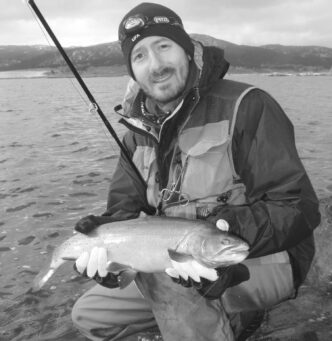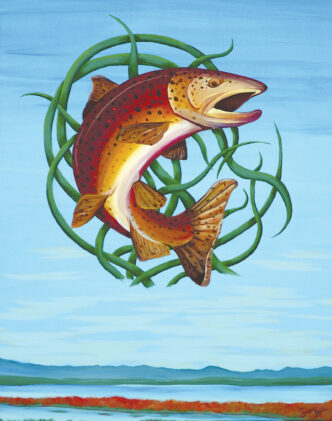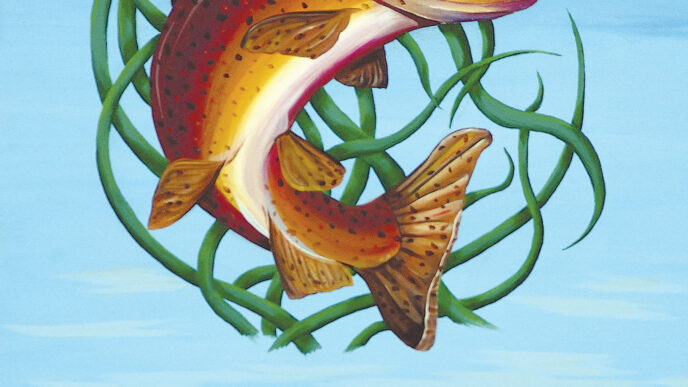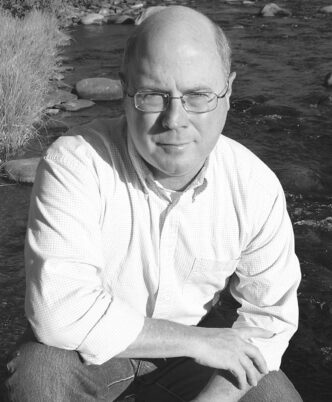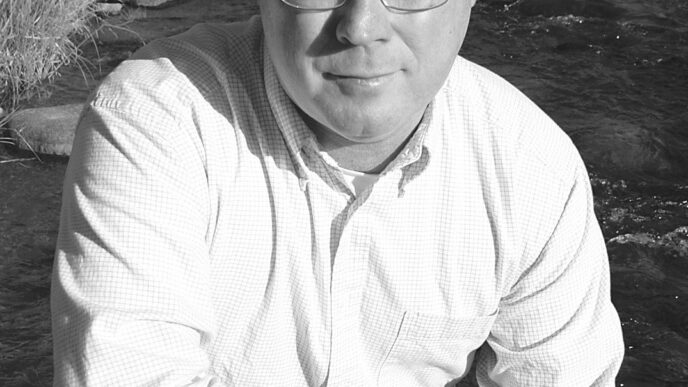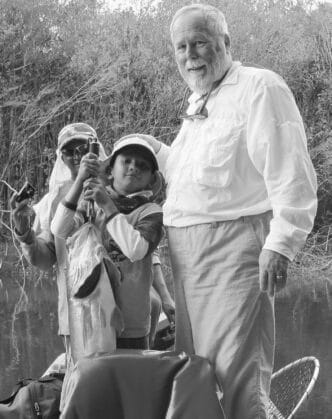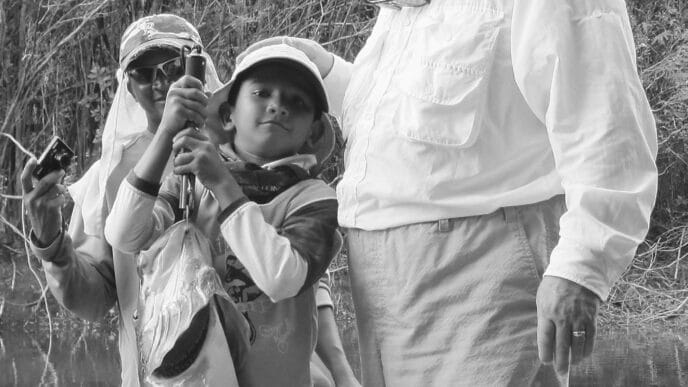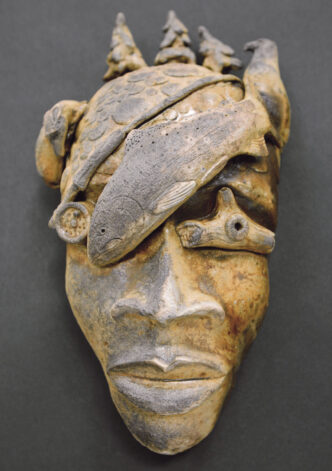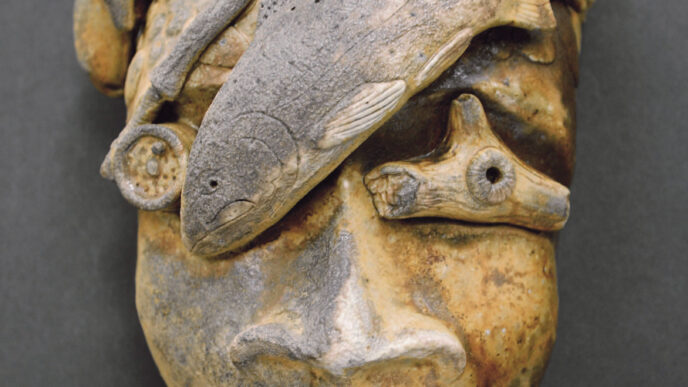Rivers bring life to California’s mountains and valleys and to its cities, towns, and farms, but they also bring to California those who seek to understand those rivers, both by the intuitive feelings for flowing water that so many fly fishers possess and by the scientific study of their flows and their environment. Mark Tompkins approaches rivers in both ways, as an environmental engineer with a concentration on hydrology and hydraulics who has a Ph.D. from U.C. Berkeley in environmental planning and as a passionate angler who shares his experiences of rivers and fishing as a writer and photographer. You probably have encountered Mark’s angling writing and photography in this magazine, as well as in Fly Rod & Reel, American Angler, Outdoor Life, Northwest Fly Fishing, Saltwater Fly Fishing, and many other publications. Here, we’re particularly concerned with how Mark, as an angler who is also professionally engaged with river-restoration projects in California, views the current and future state of California rivers.
Bud: You’re from the Midwest and grew up with the Chicago River as your home water. Most people know the Chicago River from the annual Saint Patrick’s Day photo of it being dyed green as it flows though the heart of downtown Chicago. It apparently also was a major feat of nine-teenth-century civil engineering, having been caused to flow into the Mississippi River basin, rather than into Lake Michi-gan, as it originally did. I can see this background as the cradle of the engineer and hydrologist you became, but not as an encouraging environment for an angler. It took a trip out West to make you a fly fisher. How did you start fishing, and what is it about the West that drew you to the long rod?
Mark: I’ve been fishing for as long as I can remember. My parents took me and my younger brother to Minnesota as little kids, and there we’d fish for perch and walleyes out on the lakes. My dad also took us on an annual trip to Lake Defiance in northern Illinois. The stated purpose of that trip was to go fishing, but every year, we’d stop fishing after an hour or so and spend the rest of the time hunting for a new painted turtle to take home as a pet. I also did a lot of saltwater fishing growing up. My parents started going to Grand Cayman before it became a well-known destination. Some of my most magical fishing memories are from Grand Cayman. We’d fill buckets with big hermit crabs — they called them “soldiers” — and fish out on the reefs. Over the years, we made lots of good friends on the island, and we’d go fishing with them, sometimes trolling for tuna and dolphins (the fish, not the mammals), other times fishing the reefs at night. We always kept and ate the fish we caught on those outings. I can still remember cleaning fish on the beach after one of those night-fishing outings. Our friend Athens had a huge lantern, and as we cleaned the fish, you could see large tarpon and sting rays cruising the beach, looking for food. My first “real” fish was a tarpon down in Sanibel, Florida — probably when I was eight or nine. So I owe my introduction to fishing to my parents. It was a pretty amazing introduction.
But I never flyfished as a kid. I never even really knew fly fishing existed! In fact, I never even fished in a river. It wasn’t until graduate school at the University of Illinois that I learned about fly fishing. I owe that to my best friend, Brandon Stell. He was my backyard neighbor all growing up until he moved to Colorado when we were in high school. We never lost touch, and at some point he started telling me about fly fishing out West. I was curious, so I ordered a rod and reel from L. L. Bean and started figuring it out in the little agri-cultural streams around the Illinois campus where I was doing my masters research. I’d catch bass and panfish and lots of odd-looking suckers and other warmwater fish. I was hooked immediately.
Not long after starting to fly fish, I began writing about fly fishing. My very first article was called “Quick Fix in a Drainage Ditch” for American Angler magazine. It was about catching, on a fly, all the crazy different species in the little warmwater creeks around every Midwestern farm. That was fun fishing.
But you’re right, it was the West that made me a fly fisher for life. The first step in that process was a trip to Idaho and Utah. I went out to Utah State for a week of training on PHABSIM (the Physical Habitat Simulation Model), a computer model, and my friend Brandon met me for a few days before the course started to roam around doing some fly fishing. It was pretty comical, looking back on it. Neither of us really knew how to fly fish for trout. We made our way to Yellowstone and the Madison River, along the way stopping at the Snake River and a couple other places in Idaho where we got skunked. We didn’t do any better in Yellowstone — I still give Brandon a hard time for putting on a huge Chernobyl Ant and slapping that thing down on the water again and again without ever even thinking about changing flies. In three or four days on some of the best trout water in America, we didn’t catch a single trout! But it didn’t matter. It really didn’t matter. Brandon departed when the course started, but every day after classes, I would run back to my dorm room, grab my gear, and head out to the creeks around Logan, Utah. I still didn’t know what I was doing, but somehow, a few days into the class, I found myself in the middle of a heavy mayfly hatch and managed to catch a few decent brown trout on dry flies. That was it for me.
The next step in the process was moving to California — Sacramento, to be exact. I got married right after grad school and my wife, Karen, and I crammed our stuff and our dog into the car and moved out so I could start a consulting job working on river-restoration and water-resources projects. This was at the same time that the CALFED program was getting into full swing, and it was really an amazing time for me to begin my career. I was already hooked on fly fishing, but it was the salmon and steelhead in California that added real magic to fly fishing for me.
One of my first fly-fishing forays in California was to the Yuba River in the fall. There were tons of salmon in the river. Once again I was a total novice and didn’t hook any steelhead, but seeing those huge salmon really added something to the experience of fly fishing for me. I’m still blown away every time I get on a river and see anadromous fish.
The thing that turned me into a real angler though was meeting my good friend Andrew Harris. I did a story on women in fly fishing for Sacramento Magazine, and Dick Galland up at the Clearwater lodge had me and my wife up for several days so she could learn to fly fish and I could take notes and pictures. I connected with Andrew, and that winter, when he was back in Davis, we started fishing the Central Valley tributaries together. I did the Clearwater Guide School the next season, and over the next few years, Andrew and I fished just about every major tributary to the Sacramento and San Joaquin (along with lots of other water), and I actually became a decent angler — nowhere near the angler Andrew is, but good enough to feel as if I finally knew what I was doing. As a fly fisher, Northern California had become my home.
Bud: In the first article that you published in California Fly Fisher, “Going West,” in the January/February 2000 issue, you wrote that, newly arrived in the Golden State, “in California, I see almost unlimited potential. If we could remove some old dams, the salmon and steelhead likely would come back in droves. If we could release water from reservoirs to replicate natural flows, trout populations surely would boom. And perhaps most important, if we could protect the few remaining haunts of wild fish in California, we would ensure that the fish would be there for our children and grandchildren. We just need to work with the tools and materials lying all around us.” It’s now more than a decade later, and with a Ph.D. in environmental planning under your belt and a lot of experience working with those tools, how does the situation of California’s fisheries look to you today? Are you sadder, but wiser? Still optimistic? How has your sense of the goals and priorities for environmental planning on California’s rivers changed?
Mark: Wow. I hadn’t realized it had been so long since I wrote that article. Time sure flies. To start, I am still optimistic. I’m an optimistic guy by nature. And now that I have three young sons — I didn’t have any kids when I wrote that — I have to say I’m super excited about reexploring the rivers of California with them and finding out if they get as excited about fly fishing as I first did. I already know they love fishing. And it won’t be long before I introduce them to fly fishing.
I guess my answer has two parts. The first part is positive. Since I wrote that article, some amazing things have happened for California rivers. Some are obvious: the agreements in place for dam removal on the Klamath; the San Joaquin River Restoration Program. Others are much quieter: the hundreds of smaller restoration projects on rivers and streams throughout the state. But in my mind, more important than these big and small projects is the “multi-objective” thinking that currently pervades management of our rivers and streams.
For a very long time, we’ve managed these resources with a single-purpose, engineer-dominated approach — an approach that I am very familiar with, since my original training was as a civil engineer. But over the past decade, the world of water-resources management has in principle shifted to try to satisfy multiple objectives in the next generation. I say “in principle,” because this has been a very difficult transition to make. Nearly every major water program in the state, from the Bay Delta Conservation Plan to the Central Valley Flood Management Program, has multiple objectives front and center. But when you dig into these programs, and I’ve been fortunate enough to be involved in most of them through my consulting work, you very quickly realize how difficult it is to address the ecosystem, water supply, flood control, and a whole host of other important objectives equally. It’s messy, and it’s hard. But the fact that the idea of multiple objectives is front and center right now is very encouraging.
The second part of my answer is not as positive. I was really naïve back then about how things work in California concerning water issues. I’m still optimistic, don’t get me wrong, but I feel as if at least now I have a decent handle on how hard change is when it comes to this resource — water — that means so many different things to so many different people.
This has become very apparent during the past few years of economic pain. As dollars get tighter, it gets even harder to achieve multiple objectives in the way we manage our rivers. And there is a very real danger of falling back into the single objective mindset of the past generation in order to make progress, because it appears easier.
I think what concerns me most about the current situation is the relatively slow pace of restoration. We spend mind-boggling amounts of time and money planning, evaluating, and negotiating restoration efforts, but the pace of real, on-the-ground implementation often feels glacial. But it does happen. The recently completed removal of the gates on the Red Bluff Diversion Dam on the Sacramento River (to enhance fish passage and improve water deliveries) shows how when everyone around the table can get behind a major change, the money and political will to get it done materializes. I personally think there are new tools and approaches just around the corner that will make implementation of multiple-objective projects more of a reality by applying twenty-first century computer hardware and software to better enable collaboration between the folks using and managing water resources and to more quickly integrate expertise on big, messy data problems. But right now, we’re in a transitional phase in which the pace of change is still pretty slow.
But the most important thing I have to say in response to this question is that right now — more than at any time in the past few decades — we are on the verge of some major changes in the way we manage the places that the fish we love to chase need if they are going to survive and thrive in the next generation. And that we all can have a very real voice in how these changes play out. The state is currently planning the way that the flood-control infrastructure along nearly all of our major rivers will change over the next 50 years and how water will move through the Delta. These are monumental changes, and we can all get involved in the discussions about them. As anglers, it is important that we at least know these things are going on, and we should really be engaging in these processes to make sure they reflect the understanding we have about the way our rivers work. All the science and studies are great and very important, but the passion for and personal connections to specific rivers and fishing spots we all have are every bit as important to the debate about what comes next.
Bud: The next article you published here, “Depth, Velocity, Substrate: A Fly-Fishing System,” in the March/April 2000 issue, was targeted at newbies of the A River Runs Through It moment in American angling history. That advice was based on how PHABSIM models fish habitats, and it urged neophytes to consider those three factors when looking for where trout might be found. What would you tell newbies these days? In the article, you discussed your own efforts to climb the learning curve as a fly fisher. How has your understanding of fishing streams developed, after more than a decade of angling experience? How does your angling experience feed back into your professional work — and vice versa?
Mark: Well, the first thing I have to put out there is that even after hundreds of days on all sorts of water with some of the best anglers around, I still feel like a newbie myself a lot of the time. And that’s with seven years of graduate research studying rivers and fish habitat. That said, my first piece of advice would be to befriend a skilled angler. Nearly all of my improvement as an angler came by fishing with Andrew Harris and watching him pull fish out of every imaginable type of water. He taught me many tips and tricks that he’d learned over the years as an angler and as a guide — things it would have taken me decades to figure out. Becoming a better angler is a lot like learning the guitar. You can read all the books and watch all the videos you want and practice on your own for hours, but you’ll get much better much faster by jamming with musicians who are better than you — and you’ll have a lot more fun doing it.
But my advice about depth, velocity, and substrate wasn’t totally useless. I think it helps to have a few simple strategies in mind when fishing new water. Rivers behave pretty consistently all over the world, and so do the fish living in those rivers. There is plenty of complexity in fly fishing, so focusing on the things that are similar about rivers, rather than getting overwhelmed by all the ways they are different, can help keep you from getting discouraged on new water.
And I guess my last piece of advice would be to spend as much time not fishing on rivers as you can stand. I’ve been very fortunate to have a career working on rivers and have spent lots more hours walking and working in rivers than fishing them. I’ve been frustrated more than a few times by not being able to fish, but it’s enabled me to see a lot of things I’m sure I’d have missed if I had a rod in my hand.
Bud: It sounds like instead of being able to combine fishing with work, it still has to be first one, then the other, as with the rest of us poor duffers.
Mark: I do my best to mix fly fishing in with my work travels, but to be honest, the chance to do so usually is pretty limited. Before I had kids, I’d try to build in more front-end or back-end time to my work trips so that I could spend some time fishing, but right now, I find myself eager to get back home with my family. Occasionally I’ll slip in a fly rod on a reconnaissance tour for a new project, but I’m usually ill-prepared on those types of outings. I recently tried this on a float of the Trinity River near Dallas, Texas. I knew there were alligator gar in the river, and figured I’d give that a go. So partway through the day, I pulled into a side channel and actually spotted a big gar cruising back and forth. I cast to him a few times, and he just looked annoyed. Then I landed a fly right in front of his nose, and he lunged for it, turned his head, and cut my line immediately. I didn’t have any leader material he couldn’t cut, so I packed it in and got back to work. I’ve also been doing some really interesting work with the Henrys Fork Foundation in Idaho, and I’ll bet I’m the only fly fisher who can say he’s walked the entire Harriman Ranch reach of that famous river without casting a single fly!
Bud: You’ve said that “combined with my academic background and deep professional experience,” your “deep personal affinity for aquatic ecosystems” as an angler “has allowed me to develop a unique approach to outdoor writing and photography.” What is that approach, and how do you see it differing from that of other writers and photographers? What can it do that other approaches don’t?
Mark: Sounds like I used the word deep a little too freely back then! There are lots of really great writers in the fly-fishing world, so I doubt I’m really all that unique. But I hope that all the time I’ve spent studying rivers does help me bring something a little different to my writing and photography about fly fishing and rivers. I’ve come to see rivers as a story unfolding in multiple dimensions — from upstream to downstream, from the surface to the bottom, through time. And I try to tell my stories about rivers through my words and my photos by connecting people with those multiple dimensions. I spent five years looking at almost every rock in Deer Creek (the one that flows into the Sacramento River near Woodson Bridge) and saw it change dramatically, but somehow it also always feels the same. I hope that my best writing and pictures give people a glimpse of that dichotomy, which is hard to grasp without spending lots of time observing rivers.
Bud: You’ve written — and published — a considerable amount in angling and other outdoor publications, and your writing is always fluid and engaging. That’s somewhat at odds with the image of the stereotypical engineer. What was your apprenticeship as a writer? What outdoor writing do you particularly admire, and what do you shun?
Mark: Well that’s nice to hear, since I don’t think of myself as a stereotypical engineer! I’m sure at least part of my capability as a writer comes from a great public-school education as a kid back in Illinois and lots of teachers who truly cared about the quality of my writing. And then I owe both my master’s advisor, Ed Herricks, back at Illinois, and my Ph.D. advisor, Matt Kondolf, at Berkeley, for helping me hone my writing skills. Ed is an ecologist who managed to thrive in one of the best civil-engineering departments in the world. He opened my eyes to writers such as Stephen J. Gould, who made dense natural history accessible and engaging, and he nurtured my writing to achieve the same. Matt taught me the art of telling a story about a river, no matter how complex the storyline. He’s masterful at engaging people with stories about how rivers change and evolve, and he’s used this skill to jumpstart some of the biggest river-restoration efforts going on in California and around the world. I use the lessons I learned from Ed and Matt in just about everything I write. But I’m a bit embarrassed to say that I’ve failed both of my graduate mentors by not publishing more of my research in peer-reviewed journals. I write a lot, but for some reason, I get writer’s block when it comes to getting my stories into the peer-reviewed journal format.
My outdoor writing got its biggest boost from early collaborations with Gary Soucie and later through my work with Richard Anderson here at California Fly Fisher, where I was given the freedom to approach topics in fun ways with the guidance of a phenomenal editor and writer.
I’ve enjoyed most of the fly-fishing writing I’ve read over the years — John Gierach, Thomas McGuane, and Seth Norman (I’m a big fan of the “Meander”). And lots of others, of course. There’s so much good stuff to read that I haven’t really found much to shun — how’s that for a diplomatic answer?
Bud: You’ve been involved professionally in studies that affect aquatic habitats throughout California, including the relicensing of the Klamath River dams, the restoration of Deer Creek in Tehama County, various other creek projects, the Bay Delta Conservation Plan, and the Central Valley Flood Management Program, among others, and now you have a seat on the San Joaquin River Restoration Program Technical Advisory Committee. That means you’ve spent your much of your professional life at the point where scientific research meets, adds to, and/or collides with the other determinants that go into the formation of public policy for the environment. How does that process look from the viewpoint of an engineer in environmental planning? How can advocates for that viewpoint secure a better hearing in a world in which it often seems that, as an old maxim in auto racing puts it, “You can’t beat cubic money”?
Mark: To start, the engineer in me sees this process as terribly inefficient. But then the planner and scientist in me sees it as totally understandable. Natural-resource management isn’t much different from most of the other big public-policy issues of the day. In the end, solutions require trust and compromise. The tough reality is that our rivers are working very hard doing lots of different jobs and will have to continue doing so. The opportunity is that we can change the ways in which rivers are allowed to do these jobs. But change is hard, so in my opinion, the essential first step in having your voice heard in the debate about how rivers and fisheries are managed is to genuinely listen to and understand the voices coming from different perspectives. As I said earlier, we have entered into an era in which the institutional framework is in place to accommodate multi-objective management of our rivers. The next big challenge is to advance the scientific and political debates into this same framework, which will require a commitment to maximizing transparency and collaboration in both of these arenas. As I said, I’m confident that there are some technological tools and approaches that will advance this transparency and collaboration in natural-resources management during my working life. But I’m an optimist, remember?
Bud: If you could wave a magic wand and cause there to be just one change in the
way in which aquatic habitats are managed, what would it be? And what would we need to do to make that magic actually happen?
Mark: OK, so I guess I’m at least partially a stereotypical engineer, since the idea of a magic wand is pretty hard for me to get my head around. But if I could wave my magic fly rod and make one thing happen, it would be to give people the time and the tools to allow real collaboration in the management of aquatic habitats. There will always be uncertainty about what we “know” about how aquatic habitats function, and there will always be a need for more science to reduce that uncertainty. But there will also always be lots of competing demands for water from California rivers and the need to make very hard decisions about how best to manage that water. The big restoration efforts in aquatic resources right now get communicated in ten-thousand-page documents summarizing the work of hundreds of people, and quite frankly, no one person can ever hope to understand them. So as I just mentioned, our ability to make the best decisions when they need to be made will require better communication that builds trust. If my magic fly rod could give people on all sides of this issue a way to get closer to being on the same page, I think we’d see some real improvements pretty quickly. To make this happen, we’ll all need to be willing to let go of some of our favorite tools and approaches and, perhaps more importantly, be willing to be wrong about some of the things we think we know.
Bud: Here we are at the obligatory Silly Tree Question. If you were a tree, what kind of a tree would you be?
Mark: This is an easy one. I’d be an alder. But not just any alder. I’d be one of the massive old white alders with its roots wrapped around the big boulders of the Copco 2 bypass reach of the Klamath River. They’ve been able to get established and grow big and tall right in the middle of the river, because most of the flows are routed around this stretch of river to produce power. My guess is that someday these alders will have a front-row seat from which to observe how a river responds to the removal of large dams. I think I wrote in one of my articles for California Fly Fisher about the need to sit back like Siddhartha and watch a river to truly understand how that river works. Being one of those white alders would be my path to true enlightenment about how river restoration really works!



